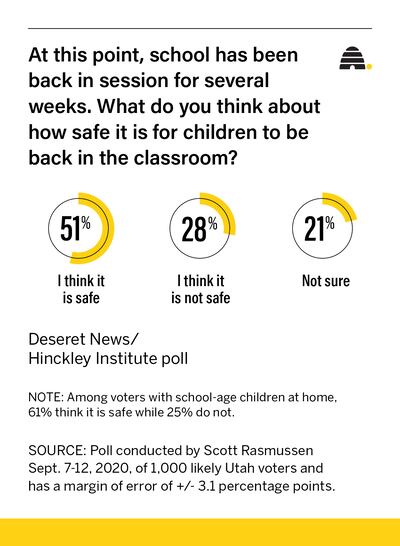SALT LAKE CITY — No one knew what to expect when Utah students returned to classrooms after the COVID-19 pandemic forced schools to suspend in-person learning last spring.
State education and public health officials labored over the summer to develop guidance on everything from mask wearing, hygiene, movement of students and staff in school hallways or building entrances and what to do if someone was diagnosed with coronavirus.
Plans in place, most Utah schools have been back in session for several weeks, some more than a month. Do Utahns perceive it’s safe for children to be back in classrooms?
Just over half of Utahns — 51%— think it is, according to a new Deseret News/University of Utah Hinckley Institute of Politics poll.

The survey of 1,000 likely voters in Utah also found that 28% said it is not safe and 21% are not sure.
The poll, conducted by independent pollster Scott Rasmussen Sept. 7-12, has a margin of error of plus or minus 3.1 percentage points.
State Superintendent of Public Instruction Sydnee Dickson said the poll results mirror the feedback state education officials have received from parents and community members. Most feel confident in sending their students back to school, she said.
“But there’s also some uncertainty of just knowing what information to believe because there’s so much information out there,” she said.
Dickson said data collected by local health departments and reported by schools shows “when there are cases in schools, most of them tend to be connected to neighborhood, family or community activities where they have picked up the virus. Schools are cleaner than they’ve ever been. Masks are making a difference.”
Among parents of school-age students, 61% said it is safe for students to be back in classrooms, which Dickson attributes to families’ experiences since school started.
“It’s both their confidence in public schools and wanting their students to be in school face-to-face. There’s a recognition that schools are not only there for academic needs but mental health needs as well. They are safe places for our students. For some of our students, it’s the safest place to be,” she said.
There are also economic considerations for families who experienced emergency learning last spring, Dickson said. They prefer to have their children in school with teachers face-to-face and learning with their peers.
“There’s a sense of safety that comes with that normality of having students in school face-to-face,” she said.
Heidi Matthews, president of the Utah Education Association, said the poll question didn’t capture the complexity of safely returning to school during a pandemic.
“We know that the students are less at risk themselves. They’re relatively safe but they are carriers and they do transmit to their parents, family members and their teachers and the adults in the school. So while it might feel safe for our students, we, the UEA, represent educators who are in the classrooms. This question doesn’t go far enough because our adults are at risk,” Matthews said.
Worse yet, as some school districts have experienced outbreaks, they have not strictly followed state or local health department guidelines when COVID-19 cases exceed 15 in a school or three in a classroom, she said.
“They’re moving in the opposite direction of what the health department has recommended, and that should not be acceptable,” she said.
When outbreaks occurred at Jordan School District’s Riverton High School and Canyons School District’s Corner Canyon High School, neither fully implemented the Salt Lake County Health Department’s recommendations, which were to close schools for 14 days, shift to online learning and to suspend school activities. They did follow the recommendation for deep cleaning of schools.
On Friday night, the Canyons School Board voted to place Corner Canyon on remote learning and deep clean the school, but school activities will continue except when three or more members of a group test positive for COVID-19. Earlier, the school was shifted to a split school schedule to reduce the number of students in school buildings at one time.
In the face of record daily case counts in Utah this past week, with Friday setting the mark of 1,117 positive test results, UEA called on the governor and state and local school boards to do more to ensure teachers’ places of work are as safe as possible.
“We have from the beginning have been saying we need accountability measures. School plans need to be based on science not the will of the elected officials,” Matthews said.
The statewide poll results reflect diverse perceptions along ideological, political and religious lines.
For instance, 76% of people who identified as conservative said it was safe for students to return to school. Meanwhile, 62% of people who identified as liberal said it was not safe.
Among Republicans, 72% said it was safe for kids to return to school while 59% of Democrats said it was not safe.
With respect to faith lines, among respondents who are members of The Church of Jesus Christ of Latter-day Saints, 62% said it was safe for Utah children to return to in-person learning. Among people of other faiths, 45% said it was safe while people who selected “none” when asked their religious preference, 24% said it was safe.


